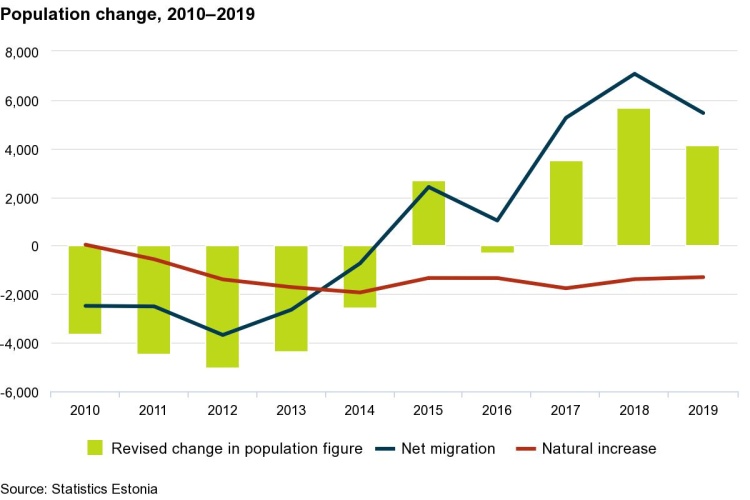Analytics, Demography, Estonia, Society, Transport
International Internet Magazine. Baltic States news & analytics
Wednesday, 24.04.2024, 17:54
Immigration helped to increase the population figure in Estonia
 Print version
Print version14,099 children were born in Estonia in 2019, which is a couple of hundred less than the year before. According to Alis Tammur, leading analyst at Statistics Estonia, we have come to a demographic situation where the number of women of childbearing age decreases each year. “The small decline in the number of births did not, however, have a significant impact on the total fertility rate: in 2019, it was 1.66, and in 2018, it was 1.67. For the second year in a row, considerably more families in Estonia are having third or successive children,” added Tammur. The total fertility rate increased sharply in 2018, when the government started to support families with three and more children.
The number of deaths has remained stable for over a decade, which in an ageing society signifies increased life expectancy. The difference in the number of deaths and births has been in the range of 1,300–1,900 for the past eight years. The stable natural change is the result of overall demographic development: life expectancy and the number of children born per woman are increasing.
In 2019, Estonia’s net migration was positive for the fifth year in a row. 18,259 persons took up residence in Estonia, and 12,801 persons left Estonia. Immigration was record-high compared to the previous year, but there were also a few thousand more emigrants. Immigration went up a few years ago, but as a large share of immigration is short-term, emigration has started to increase now as well. Net migration was by 1,500 persons lower than in 2018.

Estonian citizens accounted for the biggest share of both immigrants and emigrants. Their net migration was positive for the third year in a row. The most movement still took place between Estonia and Finland. More people moved from Finland to Estonia than from Estonia to Finland also for the third year in a row. Citizens of Ukraine and Russia accounted for the largest number of immigrants.
At the same time, the net migration of European Union citizens was negative for the first time in years.
In calculating the population figure, Statistics Estonia uses rules for identifying permanent residents, i.e. the residency index. See how register data are used to determine who is a permanent resident and who has left Estonia. More detailed information on the residency index is available in Quarterly Bulletin of Statistics Estonia 1/2017.
For the statistical activity „Population“, the main representative of public interest is the Ministry of Social Affairs, commissioned by whom Statistics Estonia analyses the data necessary for conducting the statistical activity.
- 29.12.2020 В Латвии вводят комендантский час, ЧС продлена до 7 февраля
- 29.12.2020 Latvia to impose curfew, state of emergency to be extended until February 7
- 29.12.2020 Number of new companies registered in Estonia up in 2020
- 28.12.2020 Рынок недвижимости Эстонии осенью начал быстро восстанавливаться
- 28.12.2020
- 28.12.2020 Tartu to support students' solar car project
- 28.12.2020 Латвия прощается с российским углем
- 28.12.2020 Owner of Kunda Nordic Tsement to install full-scale CCS facility in Norway
- 23.12.2020 В 2019 году выросли прибыль и оборот Eesti Pagar
- 23.12.2020 За подарки стоимостью более 45 евро из Великобритании нужно будет платить таможенный налог и НДС








 «The Baltic Course» Is Sold and Stays in Business!
«The Baltic Course» Is Sold and Stays in Business!

